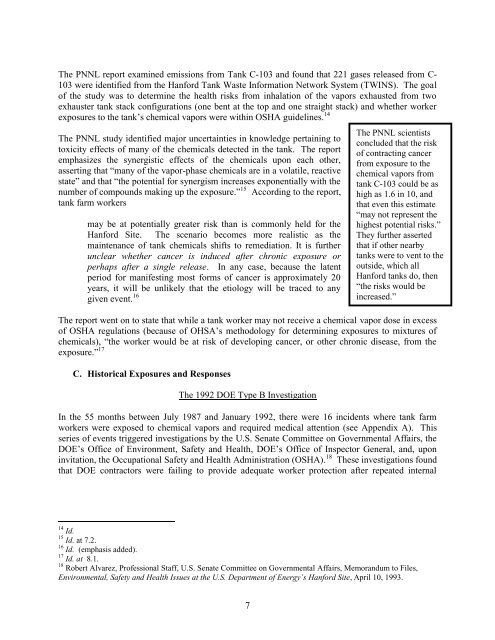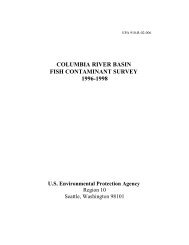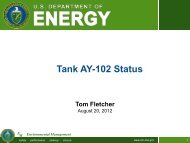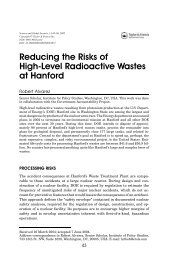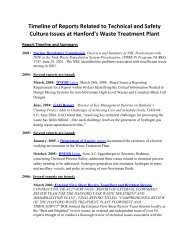Knowing Endangerment - Hanford Challenge
Knowing Endangerment - Hanford Challenge
Knowing Endangerment - Hanford Challenge
Create successful ePaper yourself
Turn your PDF publications into a flip-book with our unique Google optimized e-Paper software.
The PNNL report examined emissions from Tank C-103 and found that 221 gases released from C-<br />
103 were identified from the <strong>Hanford</strong> Tank Waste Information Network System (TWINS). The goal<br />
of the study was to determine the health risks from inhalation of the vapors exhausted from two<br />
exhauster tank stack configurations (one bent at the top and one straight stack) and whether worker<br />
exposures to the tank‟s chemical vapors were within OSHA guidelines. 14<br />
The PNNL study identified major uncertainties in knowledge pertaining to<br />
toxicity effects of many of the chemicals detected in the tank. The report<br />
emphasizes the synergistic effects of the chemicals upon each other,<br />
asserting that “many of the vapor-phase chemicals are in a volatile, reactive<br />
state” and that “the potential for synergism increases exponentially with the<br />
number of compounds making up the exposure.” 15 According to the report,<br />
tank farm workers<br />
may be at potentially greater risk than is commonly held for the<br />
<strong>Hanford</strong> Site. The scenario becomes more realistic as the<br />
maintenance of tank chemicals shifts to remediation. It is further<br />
unclear whether cancer is induced after chronic exposure or<br />
perhaps after a single release. In any case, because the latent<br />
period for manifesting most forms of cancer is approximately 20<br />
years, it will be unlikely that the etiology will be traced to any<br />
given event. 16<br />
The PNNL scientists<br />
concluded that the risk<br />
of contracting cancer<br />
from exposure to the<br />
chemical vapors from<br />
tank C-103 could be as<br />
high as 1.6 in 10, and<br />
that even this estimate<br />
“may not represent the<br />
highest potential risks.”<br />
They further asserted<br />
that if other nearby<br />
tanks were to vent to the<br />
outside, which all<br />
<strong>Hanford</strong> tanks do, then<br />
“the risks would be<br />
increased.”<br />
The report went on to state that while a tank worker may not receive a chemical vapor dose in excess<br />
of OSHA regulations (because of OHSA‟s methodology for determining exposures to mixtures of<br />
chemicals), “the worker would be at risk of developing cancer, or other chronic disease, from the<br />
exposure.” 17<br />
C. Historical Exposures and Responses<br />
The 1992 DOE Type B Investigation<br />
In the 55 months between July 1987 and January 1992, there were 16 incidents where tank farm<br />
workers were exposed to chemical vapors and required medical attention (see Appendix A). This<br />
series of events triggered investigations by the U.S. Senate Committee on Governmental Affairs, the<br />
DOE‟s Office of Environment, Safety and Health, DOE‟s Office of Inspector General, and, upon<br />
invitation, the Occupational Safety and Health Administration (OSHA). 18 These investigations found<br />
that DOE contractors were failing to provide adequate worker protection after repeated internal<br />
14 Id.<br />
15 Id. at 7.2.<br />
16 Id. (emphasis added).<br />
17 Id. at 8.1.<br />
18 Robert Alvarez, Professional Staff, U.S. Senate Committee on Governmental Affairs, Memorandum to Files,<br />
Environmental, Safety and Health Issues at the U.S. Department of Energy’s <strong>Hanford</strong> Site, April 10, 1993.<br />
7


